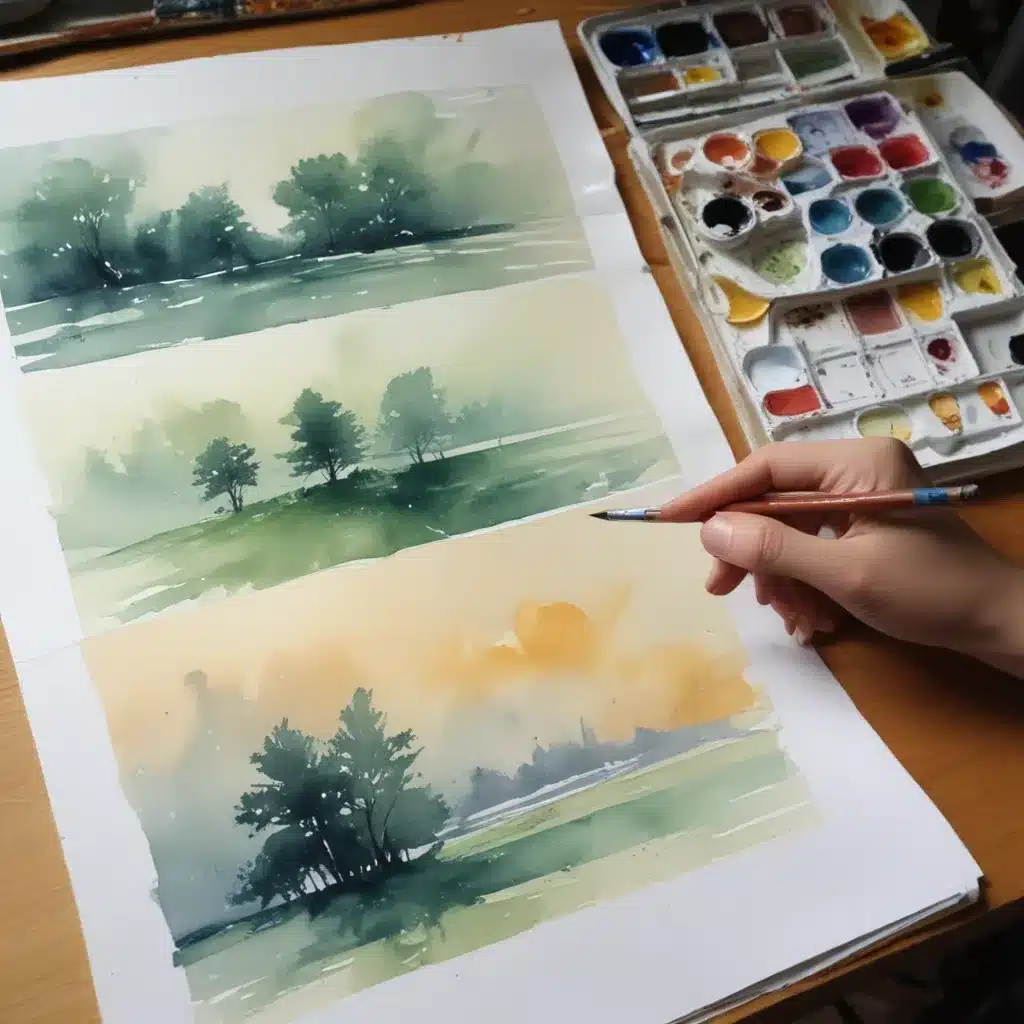
The captivating dance between control and spontaneity is at the heart of watercolour painting. This fluid, transparent medium provides a unique canvas where the artist’s intentional strokes blend seamlessly with the natural flows and effects of the paint itself. By embracing this harmonious duality, watercolourists can create evocative, atmospheric artworks that radiate expressive energy.
The Power of Watercolour Washes
At its core, the beauty of watercolour lies in the way the pigments disperse and interact with the water on the paper. Unlike more opaque media like acrylics or oils, watercolour encourages the artist to relinquish a degree of control, allowing the paint to bloom, bleed, and mingle in unexpected ways.
The watercolour wash is the foundation upon which many expressive watercolour paintings are built. By applying thin, translucent layers of pigment-infused water, artists can establish soft, atmospheric backgrounds that evoke a sense of mood and place. These washes can range from delicate, hazy tints to bold, vibrant fields of colour.
One of the joys of working with watercolour washes is the element of chance. As the paint spreads and dries, it creates organic, unpredictable patterns and textures – from dramatic blooms and granulating effects to subtle, mottled gradients. Embracing these “happy accidents” is key to unlocking the medium’s inherent expressiveness.
Balancing Control and Spontaneity
While watercolour washes allow for a certain level of spontaneity, the artist might want to also maintain a degree of control to achieve their desired result. Techniques like wet-on-wet, wet-on-dry, and glazing enable the artist to carefully build up layers, blend colours, and refine details.
For example, in a wet-on-wet approach, the artist applies pigment-rich paint to a damp paper surface, allowing the colours to bleed and merge organically. This lends a sense of fluidity and movement to the final image. Conversely, a wet-on-dry technique involves painting onto a dry surface, which produces sharper edges and more precision.
Glazing, the process of applying successive thin, translucent layers of colour, allows the artist to gradually develop depth, luminosity, and atmospheric effects. By carefully controlling the application of each glaze, the artist can guide the viewer’s eye and emphasize specific elements within the composition.
Expressive Watercolour Exercises
Striking the right balance between control and chance is an ongoing exploration for watercolour artists. The following exercises can help you discover your own creative sweet spot and develop a more expressive, atmospheric painting style.
Experiment with Salt and Sponging
One way to introduce unexpected textures and patterns into your watercolour paintings is by using common household items like salt and sponges.
To begin, apply a wet-on-wet wash to your paper, then sprinkle coarse salt over the damp surface. As the paint dries, the salt will absorb the pigment, creating a unique, crystalline effect. You can experiment with different types of salt, as well as the timing and density of the application, to produce a variety of results.
Alternatively, try sponging paint onto your paper. Lightly dab and lift the sponge to create soft, organic shapes and patterns. This technique can be especially effective for suggesting atmospheric elements like clouds, mist, or foliage.
Embrace Loose, Gestural Brushwork
Instead of focusing on precise details, try approaching your watercolour paintings with a more expressive, gestural brushwork. Use larger, freer brush strokes to capture the essence of your subject, rather than rendering every nuance.
Begin by practicing loose, fluid mark-making exercises. Dip your brush in paint, then allow it to dance across the paper, creating spontaneous lines, shapes, and textures. Experiment with different brush sizes, angles, and paint consistencies to develop a versatile repertoire of expressive brushwork.
As you translate these gestural techniques into your paintings, resist the urge to overwork or tighten your strokes. Allow the paint to flow and mix organically on the paper, celebrating the inherent unpredictability of the medium.
Explore Watercolour Resist Techniques
Watercolour resist techniques offer another avenue for balancing control and chance. By using various masking materials, you can create areas of the painting that resist the flow of the paint, resulting in crisp, defined edges and shapes.
One popular resist method is masking fluid, a liquid latex that can be applied to the paper to protect specific areas from the paint. Once the mask dries, you can freely apply washes around it, then peel away the fluid to reveal the preserved white space underneath.
Alternatively, try using wax resist crayons or oil pastels to draw directly onto the paper before painting. The waxy materials will repel the watercolour, allowing you to incorporate graphic, linear elements into your compositions.
Experiment with layering resist techniques, painting around masked areas, and lifting or removing the masking materials at different stages of the process. This interplay between controlled and unpredictable elements can infuse your watercolour paintings with a dynamic, expressive quality.
Developing a Distinctive Watercolour Style
As you explore these watercolour exercises and techniques, remember that the true essence of the medium lies in its inherent duality. By learning to embrace both the control you can exert over the paint and the spontaneity it encourages, you’ll unlock new avenues for creative expression.
Developing a distinctive watercolour style is an ongoing journey of experimentation and self-discovery. Keep an open mind, be willing to take creative risks, and Trust the unfolding process. The rewards of this harmonious balance between control and chance will be evident in the captivating, atmospheric artworks you create.
For more inspiring watercolour tutorials and creative insights, be sure to visit Pencil and Paint Muse. Our team of experienced artists and writers is dedicated to empowering emerging creatives with the skills, techniques, and inspiration they need to bring their visions to life.
Tip: Practice daily sketching to continually refine your technique